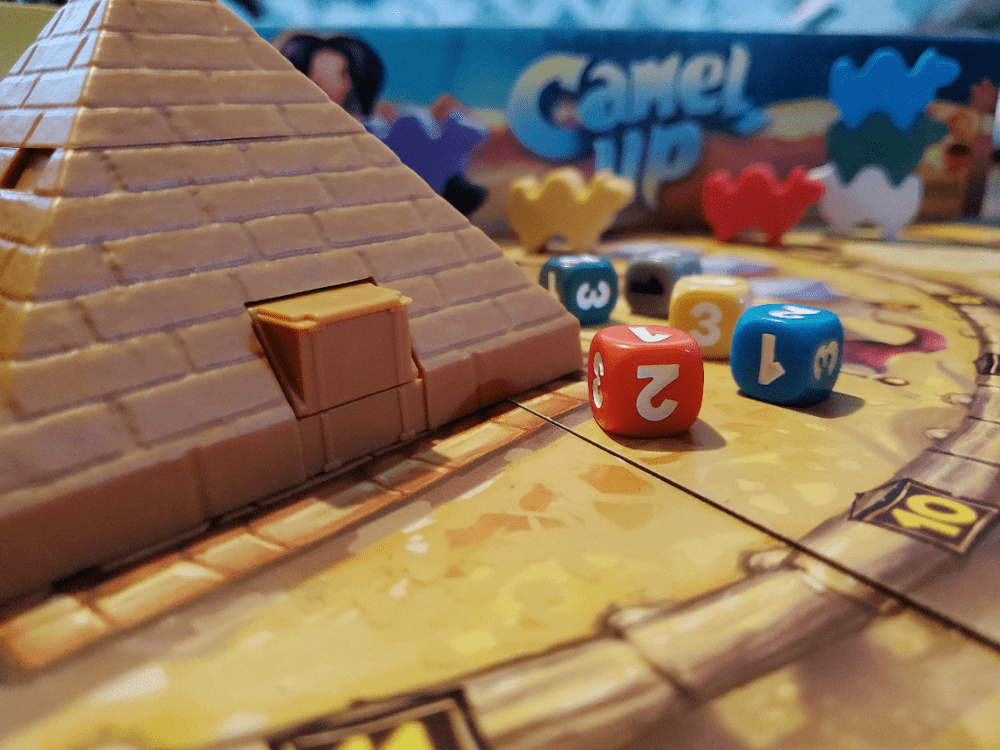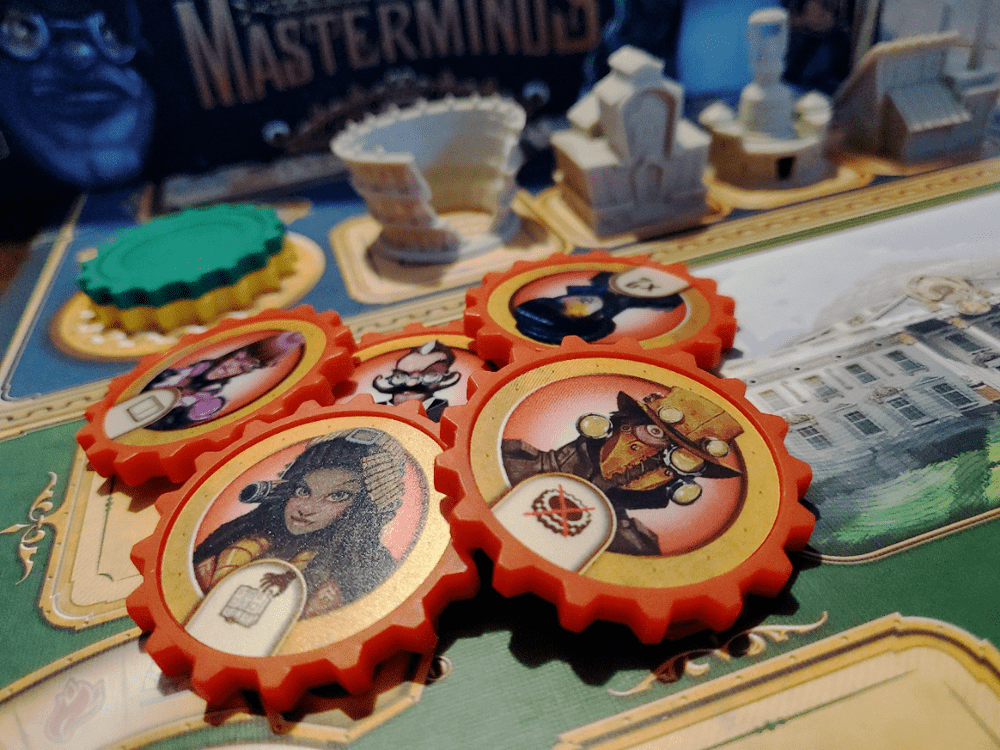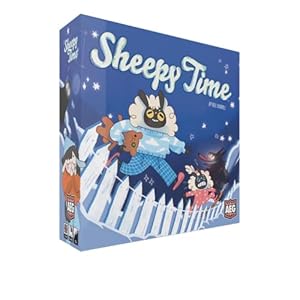Amid the hundreds of titles and thousands of components that have passed through my hands, I’ve noticed something. Most components are just components: bits of wood, plastic, metal, stock, or cardboard that serve mechanical functions. They are cards to play, meeples to move, miniatures to admire, coins to spend.
From time to time, though, I handle a component and it occurs to me: now THAT component was more than just another bit. Yes, it serves its gamified purpose, but it does so with more joie de vivre. It transcends its function and gives an unexpected life to the game.
There are plenty of games out there that are irresistibly touchable, but that’s not quite what I’m going for here. I’m talking about a singular piece. You must understand: I’ve had a hard time nailing down the definition of this component, and it has taken me a while to gather six examples from my collection. Indulge me, though, as I present some of my qualifications.
This component is available in the game’s retail edition. No deluxification here, folks. This is more than a matter of mere dollars and cents, more than a material upgrade. The component in question is essential to the game’s intended experience. So while I love the elevated clouds in my Collector’s Edition of Petrichor, I cannot include them because they are not necessarily on everyone’s table.
This component is not a gimmick. Several games are so highly dependent on one component that they cross into the land of the gimmick. Gimmicks aren’t necessarily bad, but they are often so crucial to their games that they can’t help but become the game’s ethos. Alas, I must leave out the likes of the lego-style dice in Dice Forge or Dice Realms. While they border on genius, they do not enhance, they simply are the game.
This component is not a generic upgrade. Metal coins are better than cardboard chits. Stamped wooden resource tokens are better than cardboard chits. Miniatures are (sometimes) better than standees are (sometimes) better than meeples. We all (somewhat) know this. The move from cubes to not-cubes is exciting, but I’m looking for something more poignant. Not just cute, but consequential…and maybe cute, too.
This component is more than bloat. Perhaps that’s a harsh way of saying it. I have some games where certain bits and pieces are spectacular, but they are almost the opposite of what I’m describing. Obviously I adore the miniatures in Marvel: United or The Grimm Forest, but if the games weren’t more than their plastic, I wouldn’t play them. I’m not saying a mini couldn’t make this list, but it would have to be a highly emblematic miniature that blights the game by its absence far more than it blings it out by its presence.
Ahem, but…We’ve reached the portion of the article where I contradict myself. This component might be the nicest component in the box, the one place where the publisher felt the need to go deluxe. This component might be the best or only way to carry out some portion of the game, only degrees shy of a gimmick. This component might be excessive in its production. And yet, what I’ve sensed is that certain bits walk the impossible tightrope of enhancing while remaining above reproach.
This component is function and personality rolled up into one. This component is vital. Essential. Fancy. Interesting. It is the sort of piece that you hold in your hand, recognizing the publisher could have executed in some simpler way. But it is also the sort of piece that you would never want to play without. The game becomes something by its presence.
Perhaps I should stop describing and provide some examples. Along the way, I hope you come up with some you might add.
Camel Up (Second Edition) – The Pyramid
I’ve not been shy about my love for Camel Up. There are several components here that are among my favorites in any game. The pop-up board is the definition of giddy delight. The stacking camels are a tactile phenomenon. But the plastic Pyramid is the piece that everyone flocks to in their first (and every subsequent) play.
What I find fascinating about Camel Up is that there is an equal amount of love for the cardboard-and-rubber-band Pyramid of the First Edition. Oddly, this love only bolsters my opinion that the Pyramid is at the heart of the camel race. It proves that there are multiple ways of selecting and rolling a random die to advance the knock-kneed quadrupeds. But the game just wouldn’t be right without a wonder of the ancient world resting in the middle of the board. It’s not just that the camels are racing. They are racing around the Pyramid.

The Second Edition replaced the cardboard with plastic. Rather than having to invert the Pyramid to trigger the banded cardboard, a simple button now opens the chute, allowing a single die to pass from the inner chamber to the board below. Every shake of the Pyramid makes the right kind of noise, building excitement for each six-sided revelation below. It embodies the tension of the race and the absurdity of the experience.
Victorian Masterminds – The Agent Cogs
Victorian Masterminds flirts with bloat in more ways than one. There is almost no need for plastic miniatures of every building. Wooden bits would have sufficed and made the price even more approachable. While the scientist busts are cute, I could have lived with something less molded. The Agent Cogs, however, are the most handled bit and provide a physical gratification that is almost beyond explanation.
Throughout the game, these Cogs serve as workers. They are played face-down into the game’s five locations until they become a stack of three, at which point they are flipped and revealed in order. Sure, they could have been made of a good, sturdy cardboard and served the same purpose. But these little discs, chunkier than a poker chip, do more to the game than just demonstrate interest in a location.

Throughout the entire game, players fidget with these Cogs. They are thinking pieces, picked up and dropped like poker chips, shuffled and tinkered with from start to finish. There is something about this component that makes the efficiency race feel like an efficiency race. Drawing the top one is exciting, as is every real or imagined reason for fiddling.
Wingspan – The Birdfeeder
I’ve already said it once in this article: there are many ways to roll dice. Most notably, they can simply be rolled on the table. Nobody needs a dice tower. But there is something supremely satisfying about the inclusion of a dice tower in a game like Wingspan. For me, the Birdfeeder is even more significant than the Eggs, as much as they remind me of little Easter candies.
In full disclosure, Wingspan was my first dice tower experience, and that might have something to do with its place on this list. But the Birdfeeder takes something mundane and makes it wonderfully thematic. It injects character from the house above to the tray below. Much like Camel Up’s Pyramid, new players flock to the Birdfeeder, playing with it before, during, and after the game. All of a sudden they’re not rolling dice, they’re feeding birds, and it matters.

Everdell – The Squishy Berry
There are some who might accuse me of writing entire articles simply to praise some aspect of Everdell. They would be justified in many cases, but Everdell is certainly a stunning physical production. And while I adore the components, they are not equal. The EverTree is excessive and often a hindrance. The Twigs are common, as is the Resin. The Pebbles are lovely, too, but the Squishy Berries are in a league of their own.
In a game that aims to convince players they are building a city and populating it with whimsical and endearing critters, I can’t help but believe the Berry gives the little furballs life. I’ve yet to see a player whose first impression of the Berry wasn’t seasoned with just a hint of amazement. They squeeze them, half expecting juice to come out. And isn’t that exactly what the game hopes to evoke?

When the folks at Starling Games set out to make a simpler companion game, an introduction to the world of Everdell, they knew they needed to leave one component out. But they also recognized that My Lil’ Everdell wouldn’t be worthy of the name without the Squishy Berry. I miss the Pebble. I love the Pebble. But if given the choice, I would jettison any component to keep the Berry. The Berry is the beating heart of the Meadow.
Parks – The Trail
There has never really been a doubt in my mind that PARKS belongs on this list. From the day I found the Kickstarter version on the shelf at the local game store, I’ve been enamored with this hiking game’s enlivened table presence. My wife and I count it among our favorites for more than its aesthetic qualities, but it’s undeniably beautiful. The card art is obviously fantastic. The Game Trayz box insert is still my favorite in the hobby. The first player marker is usually a hot commodity among my kiddos. But there is something about the Trail tiles that embodies the essence of PARKS.
Even more than the stunning artwork, I think it is the shape of the tiles that most captures my imagination. The team at Keymaster Games could have used rectangles. They could have integrated puzzle tabs and slots. There are a number of ways to assemble a trail. They chose the chevron. “Forward march!” the tiles say as they reveal each round’s varying series of destinations. The tiles hold together well enough to withstand near constant reaching and grabbing while they simultaneously teach the game’s most important mechanic—track movement.

At heart, PARKS is a hike. Nothing says it more clearly than the simple cardboard tiles of the Trail.
Sheepy Time – The Fence
Sheepy Time caught me off guard. What a strange and silly idea—fluffy sheep running away from a nightmare. And yet, this little push-your-luck race game from AEG got so many things just right. The sheeples are fluffy enough. The Nightmare is nightmarish. But after a bit of reflection, I’ve come to the conclusion that it is the fence that brings the whole picture together. No one claims it. No one spends it. Everyone simply runs towards it, jumps over it, and then begins another lap.
There is a distinct moment, a place of tension, surrounding the fence. Stopping a space or two short of the fence might raise the blood pressure as the Nightmare bears down. It might prompt a bit of haughty boasting believing the coast is clear. But the fence is a clear marker. If it were a line on the map, a mere illustration, I don’t think the effect would be as pronounced. Likewise with the sense of relief and curiosity that comes with each successful leap across the very three-dimensional white picket fence. I’m not sure why, but the spirit of the game is in the wood slats.

Sheepy Time is a labor for rest, a constant battle against the restless mind that drifts to sleep. Something about that little wooden fence speaks.
My Limited Perspective
Obviously I’ve only played the games I’ve played. My list is my list, informed by my strange brain and my limited experience. I’m sure you have a component to suggest. Maybe you have a clever suggestion to codify the definition that took a few too many bullet points to elucidate. Either way, I want to know what I’m missing.
I want to know because my favorite games tend to be the ones that present this sort of component. I would describe myself as a thematic gamer, not because of a love for a particular theme, but for a game’s ability to evoke something of its story by the conversation between gameplay mechanisms and physical design. Your suggestion might be my next obsessive play. So, please, don’t hold back.

















Add Comment